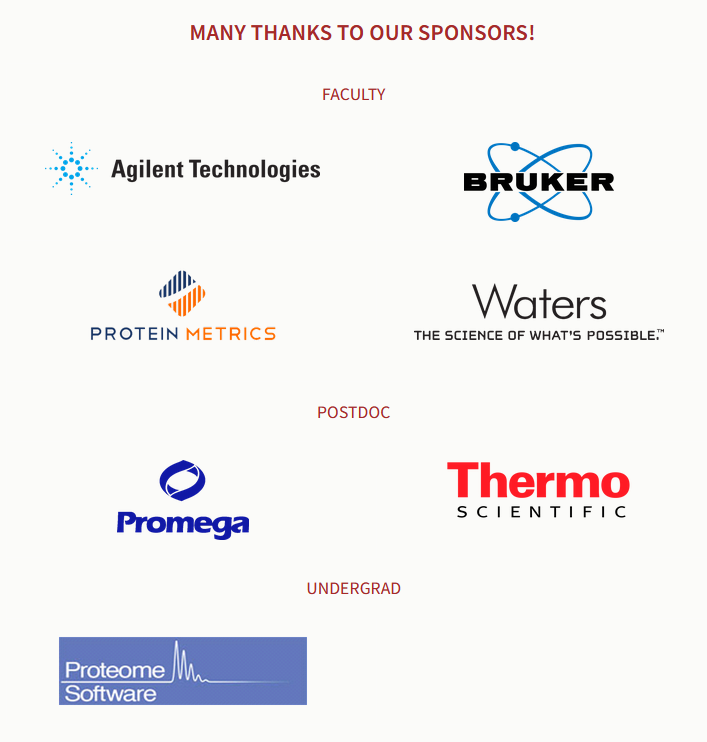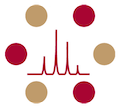2017 SUMS-RAS Sponsor Seminar Abstracts
Main content start

Thursday, October 26th, 2017
Frances C. Arrillaga Alumni Center
Fisher Conference Center
SPONSOR SEMINARS
10:40 am-11:45 am
|
Probing Protein Interactions by Mass Spectrometry
Caroline S. Chu, PhD, Application Scientist, Agilent Technologies, Inc.
Mass spectrometry is emerging as a robust and sensitivity technology for the study of protein structure, requiring very little starting material. For intact proteins, mass confirmation and putative post-translational modifications are identified. In order to study protein structure or non-covalent complexes, native MS is used. For native MS the protein is buffer exchanged into an aqueous buffer at pH 7, usually ammonium acetate which can be infused by nanoESI into a high resolution MS, such as a QTOF. For a more robust approach online buffer exchange with size exclusion chromatography (SEC) is used for online desalting using ammonium acetate and introduced into the MS by ESI. This allows for the characterization of a protein in its folded state at pH7. Here we present the use of native MS, and novel ionization techniques including, capillary electrophoresis for online electrophoretic mobility separation coupled to MS and IM-MS for high order structure analysis of intact proteins.
|
|
The TimsTOF Pro with PASEF: Digging Deeper into the Proteome with Record-Breaking Speed, Sensitivity and Robustness
Gary Kruppa, PhD, Vice President, Global Omics Solutions, Bruker Daltonics, Inc.
Proteomics researchers require mass spectrometers with increased speed and sensitivity to address the complex mixture of peptides eluting from nano-flow LC columns in data dependent shotgun proteomics workflows. The previously introduced “Parallel Accumulation Serial Fragmentation” method (PASEF, Meier et al., JPR 2015, PMID: 26538118) for trapped ion mobility spectrometry (TIMS) quadrupole time of flight (QTOF) instruments, enabled five to ten times faster data dependent acquisition of fragment ion spectra. The potential demonstrated in 2015 has now been achieved, along with even more impressive gains in sensitivity due to the 100% duty cycle, and focusing of the ions in time and space, provided by the PASEF method.
In this talk the principles of TIMS and the PASEF method, and how they enable a simultaneous gain in speed and sensitivity, at the same time, will be explained. The speed of the PASEF method is only compatible with a very fast scanning instrument such as QTOFs, and it will be shown how this combination results in full sensitivity resolution (FSR) with resolving power of 50,000 FWHM (at m/z 1222) for both MS and MS/MS data, with low ppm mass accuracy and true isotopic patterns (TIP) all at MS/MS acquisition rates in excess of 100 Hz. The benefits of the PASEF method for identifying more proteins in less time and with less sample in data-dependent shotgun proteomics experiments will be demonstrated.
|
|
HLA Peptides, Peptidoglycan, and Other Exotica
Marshall Bern, PhD, Vice President, Protein Metrics
Most proteomics search programs (Mascot, Sequest, PEAKS, and so forth) are designed for bottom-up proteomics, meaning that they give best performance on tryptic peptides in the 1000 - 3000 Da range. The field of peptidomics studies naturally occurring bioactive peptides, which occur in a wide variety of masses and modification states, and hence peptidomics is not so well-served by the best-known proteomics tools, and may fall further behind with the current push for speed and standardization. In this talk, I will show the use of Byonic, a new and more adaptable search engine, for biological research on naturally occurring peptides, including signaling peptides, glycosylated HLA Class I peptides, peptidoglycan components, and toxins from venom up to about 10 kDa.
|
|
Spatially Resolved High Resolution Mass Spectrometry for Molecular Imaging Including Metabolomics and Tissue Differentiation
LeRoy B. Martin, III, PhD, Sr. Manager, Biological Mass Spectrometry, Waters Corporation
Molecular imaging of biological materials such as tissue or cultures is a rapidly developing technique that can provide insight into processes by in situ identification of chemical markers directly from these materials. Desorption Electrospray (DESI) built on the advances of Matrix-Assisted Laser Desorption (MALDI) is currently capable of similar spatial resolution. Coupling DESI with high resolution mass spectrometry has opened up many new types of insight with direct, matrix-free sample analysis. By integrating ion mobility, these molecular imaging modalities can provide critical insight into metabolomics and drug metabolism studies.
This talk will bring together a number of technologies with an introduction to a research platform that integrates sample preparation, analysis and characterization under the control of integrated software. Images containing multi-dimensional data (high resolution mass, collisional cross section (CCS), and DIA fragmentation) will be shown. Included will be examples of tissue differentiation and microbial analysis by DESI along with an introduction on how to interpret the data.
|

